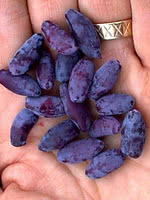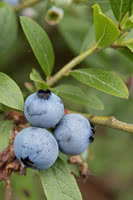Mon-Fri 9am - 5pm Mountain time
Berry Blue Haskap (Honeyberry) vs Lowbush Blueberry
Lonicera caerulea Berry Blue
Vaccinium angustifolium
NOT AVAILABLE THIS SEASON - MIGHT RETURN
Berry Blue Honeyberry is a hardy deciduous shrub. Its fruit is deliciously tart and perfect for fresh eating or production.
Berry Blue is an early pollinating variety. Pair with other early pollinators to have a higher yield.
Aurora is a great companion variety.
Haskap is the Japanese name for these berries and this term has been adopted for the University of Saskatchewan varieties. In other areas they are more commonly known as Honeyberry which is why we call this Eastern European variety Honeyberry.
Lowbush Blueberry, commonly known as the Wild Lowbush Blueberry, is often wild-harvested and thrives in low pH acidic soil. This early low-bush blueberry produces white and pink bell-shaped flowers in the spring. Its fruit is smaller in size than high bush blueberry plants and is more flavourful with an intense blueberry taste-masking it perfect for fresh eating, baking, and preserves.
Note: Blueberries require very specific soil conditions. They need well-drained soil with a pH between 4.5 and 5.0. If the starting pH of your soil is between 5.1 and 6.2 you can lower it by adding sulfur. We recommend against planting blueberries in soil with a starting pH greater than 6.2. Please do your own research before buying any blueberry plants.

